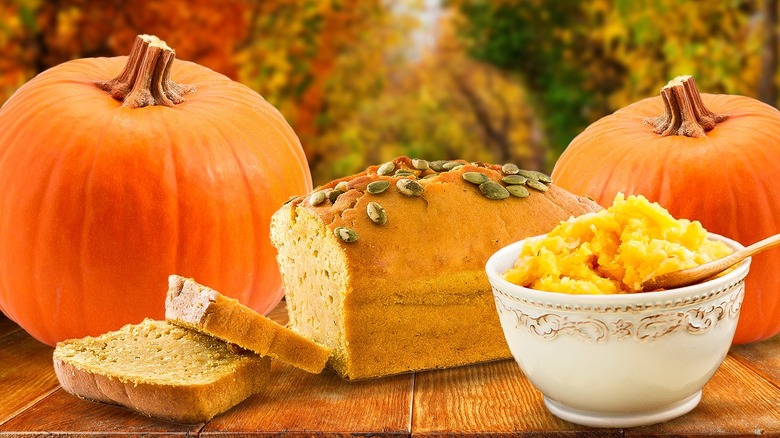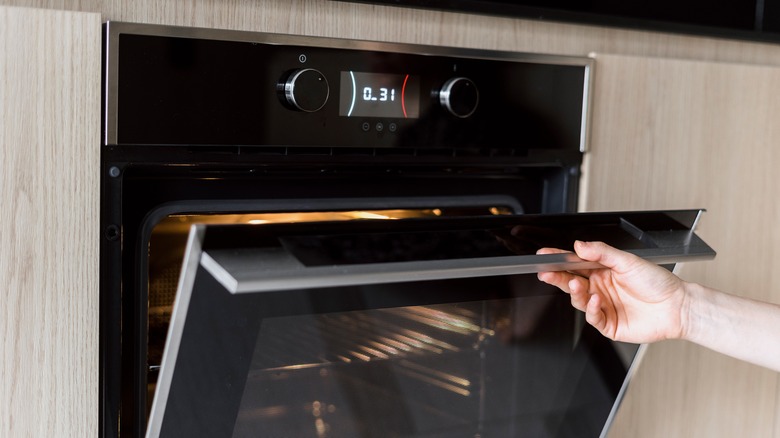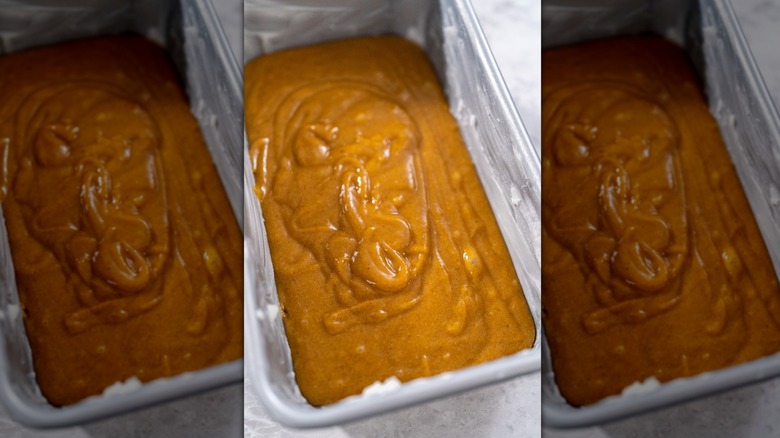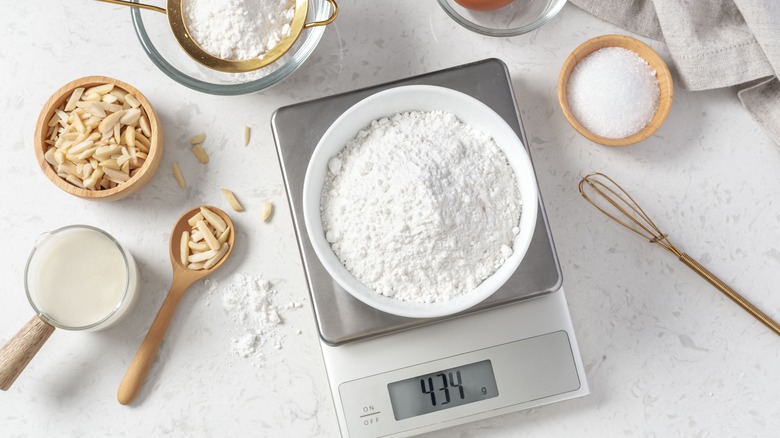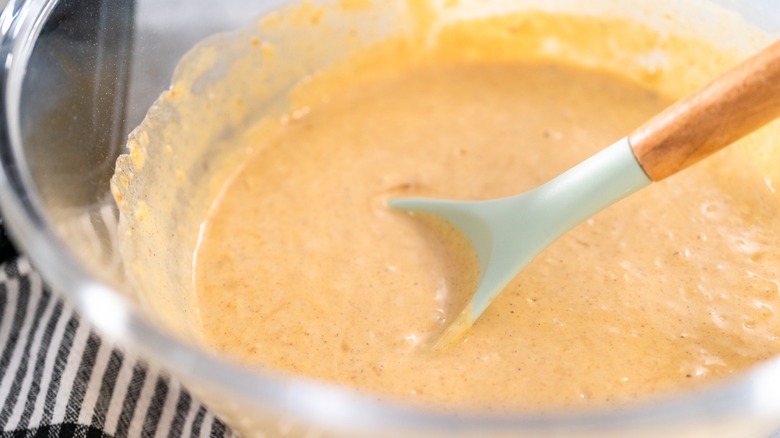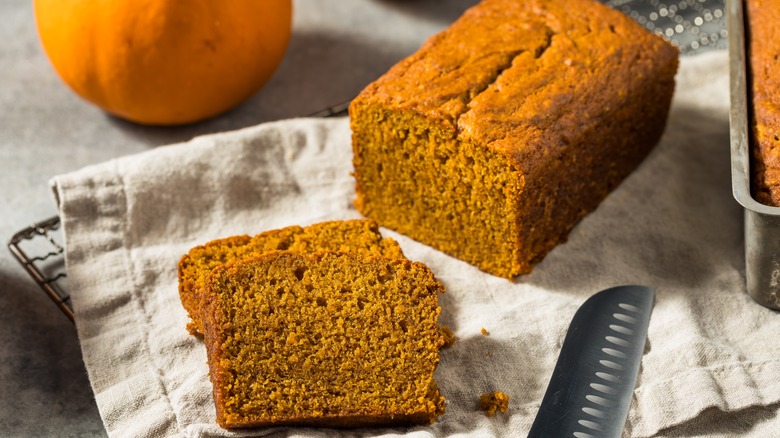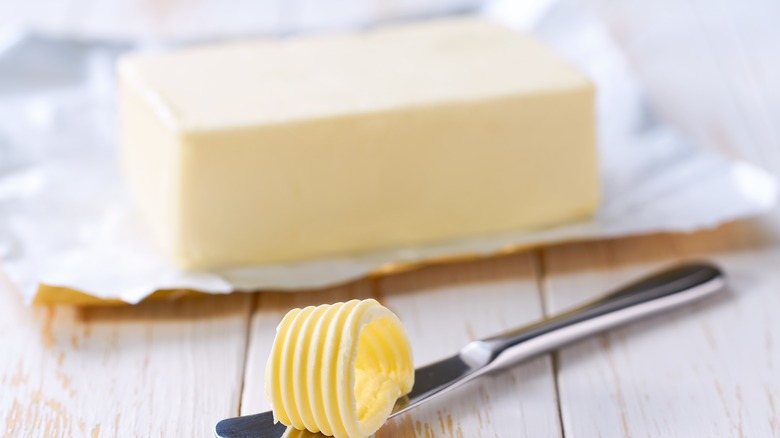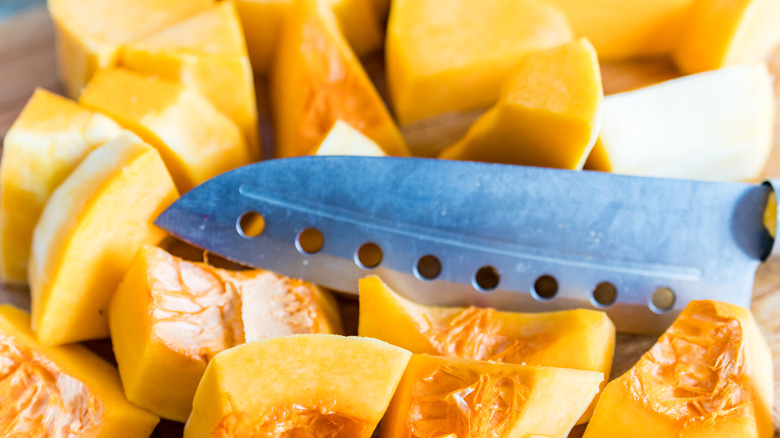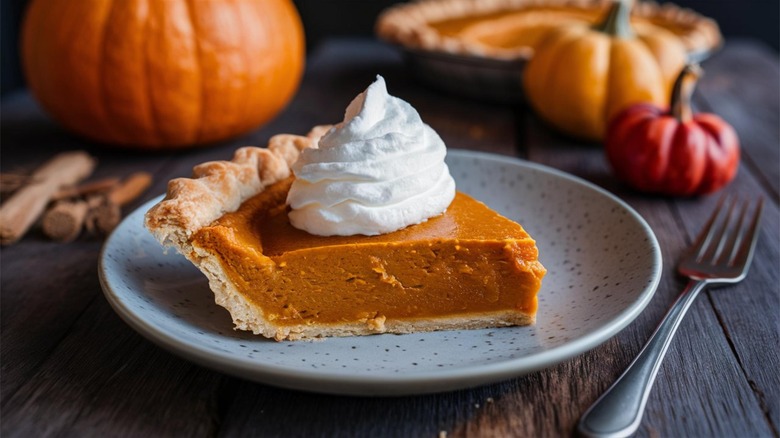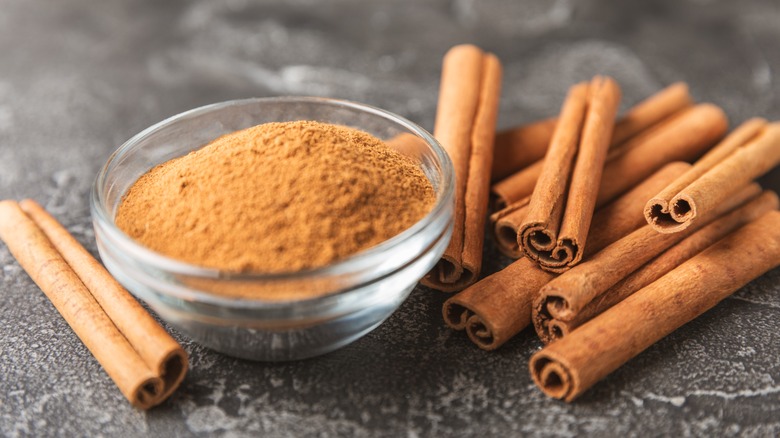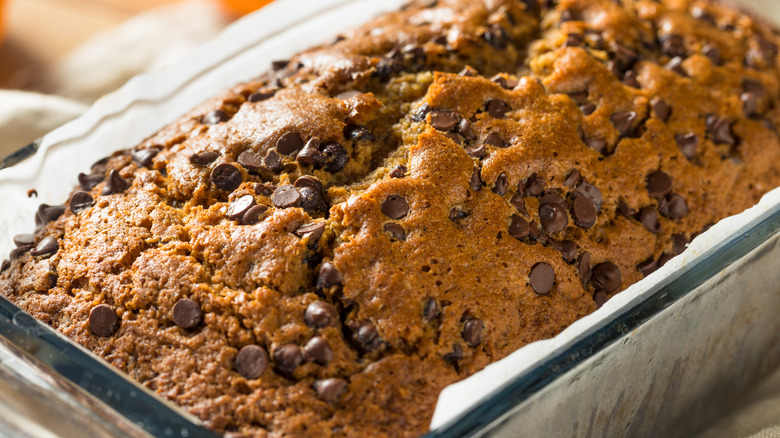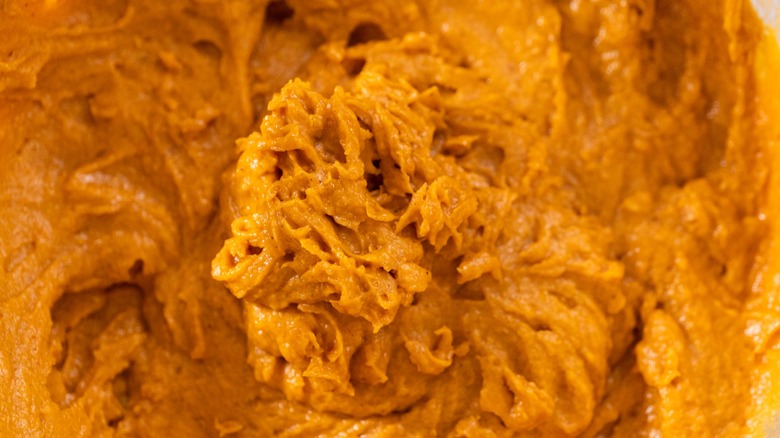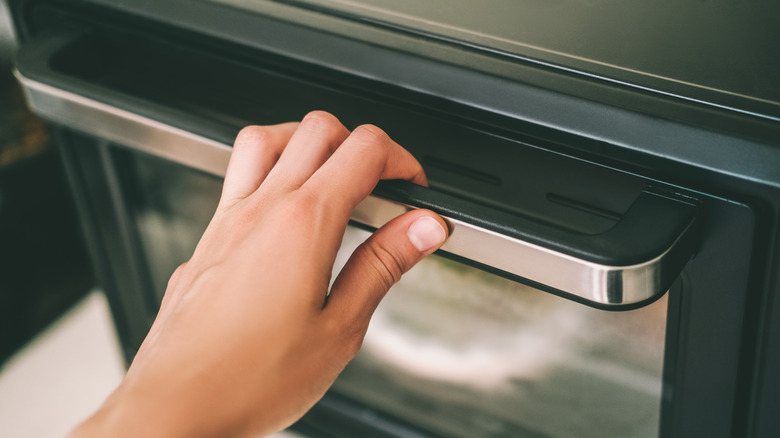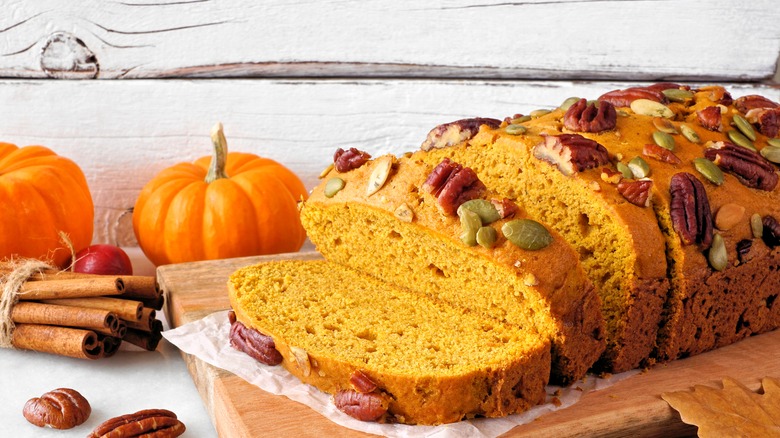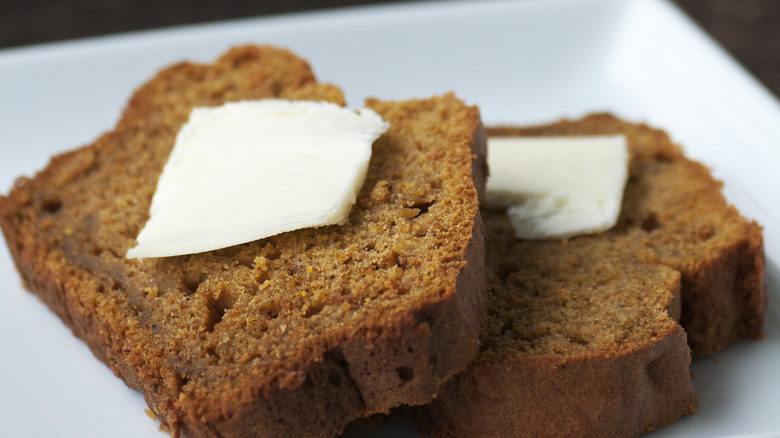The Biggest Mistakes Everyone Makes With Pumpkin Bread
Pumpkin bread is one of those recipes that I wish was more socially acceptable to eat all year round. The combination of sweet squash and warming spices in a simple quick bread recipe is predominately enjoyed during the fall months — and it's usually paired with a warm cup of tea or coffee and a plate of other autumnal treats.
This recipe is deceptively easy to make. It's why a lot of people who want to get their foot in the door with breads start with chemically leavened quick breads instead of traditional yeast-risen ones. But, there are still some mistakes that folks make with pumpkin bread that can lead to loaves that are too dry or too wet, or others that just can't compare to the slice of pumpkin bread that you'd order from Starbucks. As a home baker, I've come across many of these tricky bends during my countless run-ins with pumpkin bread, and I'm here to offer you some solutions for how to make and bake easy, tasty, and flawless pumpkin bread for autumn and beyond.
Forgetting to preheat the oven
If you're a baker, you're probably all too familiar with the line "preheat your oven." But, there's a reason why recipe developers will list it as the first step in nearly every recipe, including quick breads like pumpkin bread. It's such an important cooking step because it will prompt your bread to rise in the oven as soon at it hits the heat, rather than to slowly bake and lose moisture along the way. This can lead to a poorly risen loaf or one that has a poor texture.
Besides forgetting to preheat the oven entirely, one common mistake that folks make all too frequently is not getting the oven up to temperature soon enough. Not all ovens can rapidly preheat, and if you wait too long to turn your oven on, you'll risk your batter sitting out on the counter and wasting away. As it sits, the carbon dioxide bubbles caused by the leavening reaction will slowly fizzle out, which could put your loaf at risk of a poor rise. Don't dilly dally; turn that oven on before you pull out your ingredients.
Not adequately greasing or lining your tins
One of the other steps that's commonly (read as: purposefully) skipped over in baking is the whole bit about lining and greasing your pan. After all, a nonstick pan is called a nonstick pan for a reason, right?
Wrong. As you wash and clean your nonstick loaf pan, it will slowly weather away that protective lining. This opens up the opportunity for your loaf to stick to the edges — which will spell trouble when you go to remove the loaf from the tin. Before you start mixing up your ingredients, take a second to line your loaf pan and adequately grease it.
When I make pumpkin bread, or other quick breads, I always make sure to line the pan with a layer of parchment paper and then grease it with oil or shortening. That way, when I'm ready to remove the loaf from the pan, all I have to do is pick up the edges of the parchment and transfer it to a cooling rack.
Improperly measuring ingredients
One of the best pieces of advice that I have for novice bakers is to invest in a kitchen scale. I originally purchased my scale when I first started baking breads, but I've found that its utility has expanded into other culinary reaches, too. You should always bake with a scale because it will give you the most precise and easily replicable recipes possible. This is because when you measure dry ingredients using your trusty set of spoons and measuring cups, you'll inevitably compact them, which means that you may be adding more flour or leavening agents than you'd think to your recipe.
Normally, no one would care about a little dash of flour here or leavening agents there. But, when you're baking, you're playing with a very set ratio of ingredients and components. So, you'll want to be as precise as you possibly can be so you can make your pumpkin bread recipe just like the recipe intended it to be made.
Combining the liquid and dry ingredients too early
Have you ever wondered why a lot of recipes out there have you mix and prepare your dry and wet ingredients separately? And no, it's not because recipe developers love watching you groan about having to use (and wash) yet another bowl.
The logic behind this is simple. The moisture in your wet ingredients will interact with the leavening agents and the flour in your recipe. When baking soda comes into contact with an acidic ingredient, or your baking powder comes into contact with moisture (like water), they will start to undergo a chemical reaction that produces carbon dioxide bubbles. Meanwhile, the gluten in the flour starts to build strong bonds with the moisture, too. This will help give your bread the structure, and in turn, the lift, that it needs to be successful.
But, if you kickstart this reaction too early and continue to mix your batter, in turn strengthening those bonds, you'll risk your dough losing its lift and gaining stodginess. Mix your dry ingredients and wet ingredients separately before combining them together at the end to ensure they are well-dispersed, but not prematurely mixed.
Not using enough moisture-enhancing ingredients
There are so many different ingredients out there that you can use to soften the texture of your pumpkin bread and give it a remarkable flavor. They're not ingredients that you'll see in every recipe, so adding a little bit of them to a recipe where they are not already built-in may result in a pumpkin bread that's too moist (yes, it is possible).
Some of my favorite ingredients to play with in a recipe are sour cream and Greek yogurt. Sour cream is super, super fatty, so it will contribute to that soft mouthfeel. Plus, it helps keep your gluten strands short, thus creating a loaf that's less stodgy. If you want a little less of a sour flavor, add a scoop of Greek yogurt to the mix. This breakfast staple brings fat, protein, and moisture and will ensure that your bread is tasty and soft. You can also use mashed banana or applesauce for extra moisture, but it won't give you the same mouthfeel as the aforementioned fatty additions.
Skimping on the oils and fats
One of my biggest cooking pet peeves? When recipes encourage you to substitute out the fat with some other ingredient, like applesauce or mashed banana. There is simply no way that these low-fat ingredients can serve the fundamental purpose that oil and fat does in a quick bread — and here's why.
Fat is a conditioner; it will lubricate the gluten so that it can't form long, elasticky strands. This will not only keep your pumpkin bread moist (because it doesn't evaporate easily), but it will also ensure that your pumpkin loaf doesn't take on the texture of sandwich bread. It will also help your loaf stay fresh several days after you finish baking it.
The fat that you use for your recipe also matters. I typically avoid recipes with creamed butter or butter in general, because butter has more water content than oil does. This mean that it opens up the potential for the water to interact with the gluten and create a mouthfeel that's just not as satisfying.
Using homemade, rather than canned, pumpkin puree
I understand why someone would want to try and make their own pumpkin puree for their pumpkin bread, but believe me when I tell you this: It's not necessary. And in fact, it's one food that will surely stir up nothing but aggravation.
Homemade pumpkin puree takes a lot of work — and for little return. You'll have to slice each pumpkin in half, remove the seeds, roast it, peel it, process the pieces so that they're blended down into a slurry, and then strain off any of the residual moisture. It's exhausting just talking about it.
One of the reasons I will also prefer to use canned pumpkin puree over the fresh stuff is because the consistency and moisture in the can is standardized. Working with juicy pumpkin pulp, or failing to strain out enough of the water, will create issues in hydration, which will be passed on to your bread. Since most pumpkin bread recipes are designed with the canned stuff in mind, it's better just to stock up on it when it's on sale and use it in your recipe. Don't worry; you're no less of a baker for using this store-bought product.
Confusing canned pumpkin pie filling with pumpkin puree
Words matter when it comes to food — after all, have you ever seen what can happen when you confuse a "teaspoon" with a "tablespoon?" One of the mistakes that I see made frequently when it comes to baking pumpkin bread is when folks mix up cans of "pumpkin puree" with "pumpkin pie filling." This is such an easy mistake because the cans not only look remarkably similar, but they're often found in the same place in the store.
Canned pumpkin pie filling is pumpkin puree, plus all the spices and sugar you need to make a tasty pumpkin pie. So, if you add in a can of this compared to the unsweetened, unseasoned pumpkin puree, you'll get a wallop of sugar, spice, and everything-not-so-nice. Sure, you can cut back on the sugar and spices and use pumpkin pie filling instead, but chances are that your recipe is not designed with this substitution in mind. Luckily, there's an easy fix here; just take a second look at the can before you add it to your grocery cart.
Using the bare miniumum for spices
Pumpkin bread is delicious — and not just because of the pumpkin. It's the combination of delectable warming spices that really takes this dish to the next level. So, there's no reason why you need to have reservations about adding more than the amount of spice that the recipe calls for.
Many pumpkin bread recipes call for pumpkin pie spice in lieu of the medley of cinnamon, allspice, cloves, nutmeg, and ginger. While buying a single container of pumpkin pie spice, instead of all its components, will leave you a little more room in your spice cabinet, it also gives you less control over the ratio of spices. Cinnamon is the one spice that I tend to use more of than the others in pumpkin bread — and it's really hard to go overboard with. The others are used in smaller proportions because they're very pungent, especially the allspice. But, I tend to add a smidgen more dried ginger than the recipe normally calls for because I love the warmth that it can provide.
Not trying to add any flavorful additions to the pumpkin bread
Pumpkin bread, plain, is pretty good. But pumpkin bread, studded with copious amounts of additions? Even better.
There are tons of different ingredients you should consider adding to your recipe to boost its texture and flavor. For one, chocolate and pumpkin make a heavenly combination. You can add a handful of semi-sweet chips to the batter after you've mixed it together; the molten bits will add a remarkable textural diversity to every slice. You could also grab a handful of dried fruits (like cranberries), nuts, or seeds for some crunch and added sweetness.
It's important not to go too overboard when it comes to adding these ingredients to your pumpkin bread recipe; you still need to have a base that's more pumpkin bread than mix-ins. I'd recommend capping your additions at no more than 1 cup total per loaf pan (8 ½ inches by 4 ½ inches). This will ensure that the additions are evenly distributed and not overwhelming.
Overmixing the pumpkin bread batter
Pumpkin bread is one of those foods that is remarkably easy to over-mix. When you start stirring the wet ingredients with the dry, the gluten will start to activate and develop that distinct stringiness. While you need to give the batter some of this structure so that it can hold the slice together and so that the carbon dioxide bubbles from the leavener can get trapped, too much mixing will yield a claggy piece of bread that makes you feel like you're biting into a rubber tire.
My recommendation for making pumpkin bread is to always mix it by hand — which means leaving the stand mixer or electric beaters out of it. This will allow you to manually turn the batter, in turn giving you more control over how much it's mixed. You don't have to mix it for hours either; you'll just want to make sure there are no pockets of dry flour.
Over- or under-baking your pumpkin bread
Some bakers just seem to have a knack for knowing when their baked goods are done and ready to be pulled from the oven. Others, like me, need to seemingly try every trick in the book to determine that something is done baking and then ask someone else, "Hey, do you think this one needs like three more minutes?"
One of the visual cues that many folks look for when it comes to pumpkin bread is a distinct crack that forms down the center of the bread. This can typically tell you that the bread is finished baking or that it's nearly there. But, it's not as reliable as other methods. I prefer to test my loaf using a wooden skewer or a toothpick in two spots: one in the center of the bread, about halfway down, and the second one closer to the surface. Because pumpkin bread is so dense, you may have to test it in multiple spots to see if it's finished baking before you can confidently pull it from the oven. The internal temperature, for folks who like to triple-check their bakes, should be between 190 and 200 degrees Fahrenheit.
Slicing into your bread without cooling it down
You've gone to great lengths to ensure that your bread has come out successful and delicious. Why would you waste it all now by slicing into your bread prematurely?
While I do admit that I love a good slice of pumpkin bread, even I need to express restraint when I pull it from the oven. You'll need to let your loaf rest in its tin for about five to 10 minutes before removing it and letting it cool on a rack for the same length of time. Leaving your loaf in the tin will allow the edges and sides of the bread to finish cooking; this will help it pull out easier and also ensures that you get that beautiful color on all sides of your bread. Chances are that when you go to slice it after it's cooled on the rack, it will still be a little bit warm, but you can always pop it in the toaster or the air-fryer if you like it toasty.
Serving your slices as-is
Pumpkin bread is versatile in that you can eat it with or without a topping. If I'm enjoying a slice for breakfast, I love to add a schmear of butter on top and a drizzle of honey. The floral flavor of the honey plays well into the spices in the bread — plus that melty butter is positively irresistible. Though, if you like something a little more hearty, you can also add a schmear of whipped cream cheese to the slice; the fatty spread will give you a delectable bite.
I would recommend avoiding flavor-dominant spreads, like peanut butter, because the pumpkin has such a light, beautiful flavor that deserves to shine in your recipe. However, one unlikely pairing that you may not have considered is a drizzle of tahini. This sesame paste is remarkably nutty but doesn't really compete with the spices and squashy flavor of the bread.
